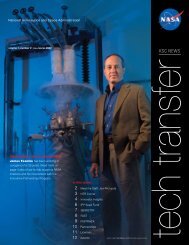2006-2007 - Kennedy Space Center Technology Transfer Office
2006-2007 - Kennedy Space Center Technology Transfer Office
2006-2007 - Kennedy Space Center Technology Transfer Office
- No tags were found...
You also want an ePaper? Increase the reach of your titles
YUMPU automatically turns print PDFs into web optimized ePapers that Google loves.
Aerocoat 7 Replacement Coatings<strong>Kennedy</strong> <strong>Space</strong> <strong>Center</strong> has used Aerocoat 7 (AR-7) to protect stainless-steel flex hoses atCorrosion Launch Complex (LC-39) and hydraulic lines of the Mobile Launcher Platform (MLP)Controlbecause it provides excellent corrosion protection in low-temperature applications. TheSovereign Company produced AR-7 exclusively for NASA but discontinued productionbecause the coating released high levels of volatile organic compounds (VOCs) and had a significantenvironmental impact. The purpose of this project was to select and evaluate potential replacementcoatings for AR-7 that would be more environmentally sound.The physical and mechanical properties of commercially available coatings were investigated throughthe Internet. The ideal coating would be fluid enough to penetrate the outer mesh of a stainless-steelflex hose and coat the inner hose, and flexible enough to withstand the movement of the hose, as wellas the expansion and contraction of its metal caused by changes in temperature. It would also be easyto apply and prepare samples for testing. Ideally, only a single coat would be necessary, applied bybrushing, spraying, or dipping.Forty-one coatings were initially selected. After evaluating the candidates against informationobtained from the Internet and coating manufacturers, we narrowed the list to 15 coatings. After thecoatings were applied, six were removed from consideration because of their reactivity, short pot life,or long curing time.Accelerated corrosion tests were performed in the salt fog chamber of the NASA Corrosion<strong>Technology</strong> Laboratory, according to the guidelines of ASTM B117. After 500 hours of exposure,five coatings performed as well as or better than AR-7 and two others were eliminated from thestudy. Figure 1 shows coatings that performed worse than AR-7, the same as AR-7 (AR-7 was thecontrol), and better than AR-7. Sample (a) was one of the coatings eliminated from the study.After 1,000 hours in the chamber, even the best-performing coatings had blisters or creepage alongthe scribe. Only two of the unscribed coatings had no blisters or corrosion spots. The four bestperformers were selected for long-term exposure testing, and scribed samples of these coatings areshown in Figure 2. After 1,500 hours of exposure, none of the coatings performed as well as thecontrol.This study will continue through FY 2008 with further atmospheric exposure and cryogenic testing.Before being included in the list of qualified products in NASA-STD-5008, the replacement forAR-7 must demonstrate that it provides acceptable corrosion protection after exposure for 18 monthsat the NASA Corrosion <strong>Technology</strong> Laboratory beachside atmospheric-exposure test site.Contact: Dr. Luz Marina Calle , NASA-KSC, (321) 867-3278Participating Organizations: NASA-KSC (Janice K. Lomness) and ASRC Aerospace (Rubiela D. Vinje andJerome P. Curran)12 <strong>Space</strong>port Structures and Materials













